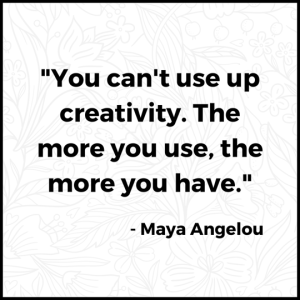8 Writing in Style
Some high school English classrooms actively make space for creative thinking and playful wordsmithing that can be immensely satisfying to young writers, but not all do. For various logistical reasons, high school writing assignments often teach students to focus more on form and technical content, leaving less room for the creative development of ideas through memorable or eye-catching titles, “hooks” or introductory statements, thought-provoking conclusions, and the incorporation of personal stories that mesmerize the reader. With so much emphasis placed on the right way to formulate body paragraphs or claims, little energy is left over to compose imaginatively. But unlike one’s personal energy reserves, creativity does not simply dry up when used too much. In the wise words of Maya Angelou, “You can’t use up creativity. The more you use, the more you have.” When it comes to matters of style, college writers are encouraged to think expansively about what’s possible when they tap into their creative inner selves and start to take creative risks that will resonate with their audience. 
Though some high school writing courses are structured to emphasize the importance of formatting and citation practices, not all do. In college, you’ll want to take special care to understand which formatting style your instructor expects you to use. Commonly, most writing courses require students to write in MLA style, but others will be open to styles that are commonly used in other humanities or scientific disciplines, such as APA, AP, CSE, or Chicago. In later chapters, we’ll unpack the differences among these styles and when to apply them.
Finally, in writing for a broader community of readers, you’ll want to cite your sources. Again, proper citation practices are sometimes taught in high school, but college writing instructors know that this is not always the case. In Chapter Seven, we’ll explore how to give attribution to each source you use and why that’s so important. If at this point, however, you feel a little overwhelmed just thinking about all the details there are to learn about style and citation practices, you might want to take a deep breath and consider how feminist author Sarah Ahmed describes citations as a form of feminist brick building. In Living a Feminist Life, Ahmed writes that “Citations can be feminist bricks: they are the materials through which, from which, we create our dwellings.” With this in mind, choose the sources you cite with care. What you choose to structure the dwelling that is your draft will make an impact on a reader, so bricks aren’t to be thrown together in haste. Choose your sources carefully and intentionally.
